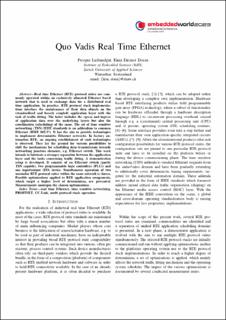Please use this identifier to cite or link to this item:
https://doi.org/10.21256/zhaw-27614| Publication type: | Conference paper |
| Type of review: | Peer review (abstract) |
| Title: | Quo vadis real time ethernet |
| Authors: | Leibundgut, Prosper Doran, Hans Dermot |
| et. al: | No |
| DOI: | 10.21256/zhaw-27614 |
| Proceedings: | Proceedings of Embedded World Conference 2023 |
| Conference details: | Embedded World Conference, Nuremberg, Germany, 14-16 March 2023 |
| Issue Date: | Apr-2023 |
| Publisher / Ed. Institution: | WEKA |
| Language: | English |
| Subjects: | Real time ethernet; Time sensitive networking; PROFINET; CC-Link; Multi protocol stack operation |
| Subject (DDC): | 004: Computer science |
| Abstract: | Real time Ethernet (RTE) protocol suites are commonly operated within an exclusively allocated Ethernet based network that is used to exchange data for a distributed real time application. In practice, RTE protocol stack implementations interlace the maintenance of their data objects on the (standardised and loosely coupled) application layer with the task of traffic fitting. The latter includes the egress and ingress of application data over the underlying layers but also the coordination (scheduling) of the same. The set of time sensitive networking (TSN) IEEE standards is an addendum to common Ethernet (IEEE 802.3*). It has the aim to provide technologies to implement deterministic Ethernet networks. In factory automation RTE, an ongoing establishment of such technologies is observed. They lay the ground for various possibilities to shift the mechanisms for scheduling data transmissions towards networking juncture elements, e.g. Ethernet switch. This work intends to fabricate a stronger separation between the application layer and the tasks concerning traffic fitting. A demonstration setup is developed. It consists of an Ethernet switch (partly TSN capable), two programmable logic controllers (PLCs) and one input/output (I/O) device. Simultaneous operation of two unsimilar RTE protocol suites within the same network is shown. Possible optimisations applied to RTE application components, which target a higher level of determinism, are presented. Measurements underpin the chosen optimisations. |
| URI: | https://digitalcollection.zhaw.ch/handle/11475/27614 |
| Fulltext version: | Published version |
| License (according to publishing contract): | Licence according to publishing contract |
| Departement: | School of Engineering |
| Organisational Unit: | Institute of Embedded Systems (InES) |
| Appears in collections: | Publikationen School of Engineering |
Files in This Item:
| File | Description | Size | Format | |
|---|---|---|---|---|
| 2023_Leibundgut-Doran_Quo-vadis-real-time-ethernet_ew2023.pdf | 5.13 MB | Adobe PDF |  View/Open |
Show full item record
Leibundgut, P., & Doran, H. D. (2023, April). Quo vadis real time ethernet. Proceedings of Embedded World Conference 2023. https://doi.org/10.21256/zhaw-27614
Leibundgut, P. and Doran, H.D. (2023) ‘Quo vadis real time ethernet’, in Proceedings of Embedded World Conference 2023. WEKA. Available at: https://doi.org/10.21256/zhaw-27614.
P. Leibundgut and H. D. Doran, “Quo vadis real time ethernet,” in Proceedings of Embedded World Conference 2023, Apr. 2023. doi: 10.21256/zhaw-27614.
LEIBUNDGUT, Prosper und Hans Dermot DORAN, 2023. Quo vadis real time ethernet. In: Proceedings of Embedded World Conference 2023. Conference paper. WEKA. April 2023
Leibundgut, Prosper, and Hans Dermot Doran. 2023. “Quo Vadis Real Time Ethernet.” Conference paper. In Proceedings of Embedded World Conference 2023. WEKA. https://doi.org/10.21256/zhaw-27614.
Leibundgut, Prosper, and Hans Dermot Doran. “Quo Vadis Real Time Ethernet.” Proceedings of Embedded World Conference 2023, WEKA, 2023, https://doi.org/10.21256/zhaw-27614.
Items in DSpace are protected by copyright, with all rights reserved, unless otherwise indicated.